Recent Articles
-
Arches National Park
Posted in North America | March 26, 2010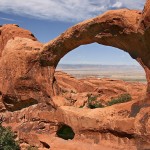 Arches National Park is a red rock wonder that contains some of the most magnificent and splendid landscapes on the planet. The park is home to the largest concentration of sandstone arches. The park has nearly 2000 arches spread over 76,518 acres. Besides the arches, there are plenty of other geological formations. Some of them include sandstone fins, huge balanced rocks, towering pinnacles, and spires. They obscure visitors to the background as they explore the park and its hiking trails. The rich history of geology has been unearthed due to geologic faulting. The ways to explore the park are as varied as the type of formations. Travelers need to devote a couple of hours to get a good introduction within the park. Those wishing to explore [...]
Arches National Park is a red rock wonder that contains some of the most magnificent and splendid landscapes on the planet. The park is home to the largest concentration of sandstone arches. The park has nearly 2000 arches spread over 76,518 acres. Besides the arches, there are plenty of other geological formations. Some of them include sandstone fins, huge balanced rocks, towering pinnacles, and spires. They obscure visitors to the background as they explore the park and its hiking trails. The rich history of geology has been unearthed due to geologic faulting. The ways to explore the park are as varied as the type of formations. Travelers need to devote a couple of hours to get a good introduction within the park. Those wishing to explore [...] -
Great Smoky Mountains National Park
Posted in North America | March 25, 2010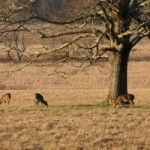 The Cherokee used word “Shaconage” to describe the Great Smoky Mountains National Park, which means “Blue, like smoke. In the entire Eastern United States, Great Smoky Mountains National Park is the largest protected land. The conserve has diverse variety of animals as well as plants species. Not only tourists or traveler are attracted to this park but also scientists from all over the world come here to discover new species of flora and fauna in these ancient mountains. The Great Smoky Mountains are a mountain range that rises by the side of the border of the southeastern United States, Tennessee-North Carolina. The mountains are substitute range of the Appalachian Mountains, which form part of the Province of Blue Ridge Physiographic. [...]
The Cherokee used word “Shaconage” to describe the Great Smoky Mountains National Park, which means “Blue, like smoke. In the entire Eastern United States, Great Smoky Mountains National Park is the largest protected land. The conserve has diverse variety of animals as well as plants species. Not only tourists or traveler are attracted to this park but also scientists from all over the world come here to discover new species of flora and fauna in these ancient mountains. The Great Smoky Mountains are a mountain range that rises by the side of the border of the southeastern United States, Tennessee-North Carolina. The mountains are substitute range of the Appalachian Mountains, which form part of the Province of Blue Ridge Physiographic. [...] -
Bryce Canyon National Park – Mesmerizing Landscape
Posted in North America | March 25, 2010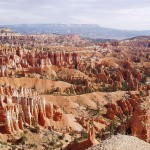 Bryce Canyon, the name itself is very confusing like the word Canyon, as Bryce is not carved by river, but the freeze-thaw cycles. Until now this huge carved stones are neither flattering nor adequate. For now, even you would agree with the people who say ‘Bryce is a Bryce’. But read further to known what is Bryce Canyon? In the southwestern Utah, is situated a small national park known as Bryce Canyon National Park. This park was created in 1928 by the Mormon Pioneer Ebenezer Bryce. The geology of the Bryce is very unique where you will find sequence of horseshoe-shaped amphitheaters stones in the southern Utah, which starts from the Paunsaugunt Plateau’s eastern border. The colorful limestone rocks have been shaped by the very forceful [...]
Bryce Canyon, the name itself is very confusing like the word Canyon, as Bryce is not carved by river, but the freeze-thaw cycles. Until now this huge carved stones are neither flattering nor adequate. For now, even you would agree with the people who say ‘Bryce is a Bryce’. But read further to known what is Bryce Canyon? In the southwestern Utah, is situated a small national park known as Bryce Canyon National Park. This park was created in 1928 by the Mormon Pioneer Ebenezer Bryce. The geology of the Bryce is very unique where you will find sequence of horseshoe-shaped amphitheaters stones in the southern Utah, which starts from the Paunsaugunt Plateau’s eastern border. The colorful limestone rocks have been shaped by the very forceful [...] -
Where is Yellowstone national park located?
Posted in North America | March 24, 2010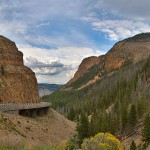 Yellowstone National Park is full of several interesting and unusual geological characteristics that cannot be found everywhere in the world. This gigantic caldera or volcanic crater is the remainder of a massive volcano that erupted many millennia ago. As the area rests on the active volcano, it has many fascinating geothermal phenomena. As this place is not known to many tourists and always. Where is Yellowstone national park located? Beside the borders of Idaho and Montana to the northwestern side of Wyoming is situated Yellowstone National Park. The location of the park is not completely in the middle of nowhere, but one could get confused. From the northeast of Idaho Falls Idaho, the park is 100 miles away; from north of Jackson Wyoming [...]
Yellowstone National Park is full of several interesting and unusual geological characteristics that cannot be found everywhere in the world. This gigantic caldera or volcanic crater is the remainder of a massive volcano that erupted many millennia ago. As the area rests on the active volcano, it has many fascinating geothermal phenomena. As this place is not known to many tourists and always. Where is Yellowstone national park located? Beside the borders of Idaho and Montana to the northwestern side of Wyoming is situated Yellowstone National Park. The location of the park is not completely in the middle of nowhere, but one could get confused. From the northeast of Idaho Falls Idaho, the park is 100 miles away; from north of Jackson Wyoming [...] -
See Grizzly Bears in the Banff National Park
Posted in North America | March 24, 2010 In 1885, the Banff National Park was created in the Rocky Mountains. It is one of the oldest national parks of Canada. It is situated in the province of Alberta to the 110 -180 kilometers to the west of Calgary. The Banff National Park land measure 6,641 square kilometers, which comprises of alpine landscape, several ice fields and glaciers, thick coniferous forest and mountainous terrain. The Ice field Parkway stretches from Lake Louise across to the north of Jasper National Park. The Banff National Park is bounded by other national parks like Yoho National Park and Provincial forests are west to it, whereas to the south is Kootenay National Park and to the southeast is the Kananaskis Country. In the Bow River valley, there is a town named [...]
In 1885, the Banff National Park was created in the Rocky Mountains. It is one of the oldest national parks of Canada. It is situated in the province of Alberta to the 110 -180 kilometers to the west of Calgary. The Banff National Park land measure 6,641 square kilometers, which comprises of alpine landscape, several ice fields and glaciers, thick coniferous forest and mountainous terrain. The Ice field Parkway stretches from Lake Louise across to the north of Jasper National Park. The Banff National Park is bounded by other national parks like Yoho National Park and Provincial forests are west to it, whereas to the south is Kootenay National Park and to the southeast is the Kananaskis Country. In the Bow River valley, there is a town named [...] -
Mt Rainier National Park
Posted in North America | March 23, 2010 Mt Rainier National Park ranks fifth national park of United States. It was created on 2nd March 1899 and measures 368 square miles including Mountains of Rainier. It is situated in Washington State to the northeast Lewis County and southeast of Pierce County. Mt Rainier National Park has outstanding attractions for mountain climbing picturesque drives, and hiking. A good number of roads are accessible from end of May to beginning of October, along with it; it has eye-catching views as well as a variety of hiking tracks and many more sites. Though several visitors plan their visit to the park for a day, mull over a thorough journeying of on one or two areas of the park. The most recommended areas are Paradise, sunrise and Carbon River. Paradise: It [...]
Mt Rainier National Park ranks fifth national park of United States. It was created on 2nd March 1899 and measures 368 square miles including Mountains of Rainier. It is situated in Washington State to the northeast Lewis County and southeast of Pierce County. Mt Rainier National Park has outstanding attractions for mountain climbing picturesque drives, and hiking. A good number of roads are accessible from end of May to beginning of October, along with it; it has eye-catching views as well as a variety of hiking tracks and many more sites. Though several visitors plan their visit to the park for a day, mull over a thorough journeying of on one or two areas of the park. The most recommended areas are Paradise, sunrise and Carbon River. Paradise: It [...] -
Beautiful Bee-Eater – Part – II
Posted in Wildlife A-Z | March 23, 2010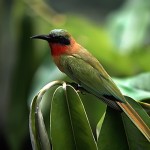 The birds have a wonderful time in Africa. Male bee-eaters have their own flocks. Grass fires attract bee-eaters in large numbers as there are plenty of insects. Spanish male birds mate with Italian female birds. It also common to see birds from Kazakhstan pair up with those from Hungary. It is back to Europe during springtime. Some of these pairs last for a lifetime. Their home usually comprises sandstone cliffs and sandy riverbanks. They hesitate to begin a family in a soiled nest. They excavate their own burrows. They have the ability to peck continuously for 20 days. At the end of the job, they have moved nearly 15 to 25 pounds of soil. This is more than 80 times their body weight. In the process, their beaks get chipped to one sixteenth [...]
The birds have a wonderful time in Africa. Male bee-eaters have their own flocks. Grass fires attract bee-eaters in large numbers as there are plenty of insects. Spanish male birds mate with Italian female birds. It also common to see birds from Kazakhstan pair up with those from Hungary. It is back to Europe during springtime. Some of these pairs last for a lifetime. Their home usually comprises sandstone cliffs and sandy riverbanks. They hesitate to begin a family in a soiled nest. They excavate their own burrows. They have the ability to peck continuously for 20 days. At the end of the job, they have moved nearly 15 to 25 pounds of soil. This is more than 80 times their body weight. In the process, their beaks get chipped to one sixteenth [...] -
Beautiful Bee-Eater – Part – I
Posted in Wildlife A-Z | March 22, 2010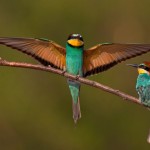 What is it with birds and poems? Keats had his nightingale, while Poe his raven. If I have to compare the life of the bee-eater with a literary work, it would be nothing short of an epic novel. The plot of the novel would be spread across several continents involving intrigue, theft, danger, chicanery, and gorgeous beauty. Can you guess how many colors are present on the body of the bee-eater? I, too, am at a loss for words. The chestnut crown blends beautifully with the black robber’s mask. The breast comprises of a turquoise blue, while the throat resembles the tinge of ripening wheat. I guess this is just what the doctor ordered for a bird that does not like to play it safe. The bee-eaters are true to their name: they eat bees. Besides [...]
What is it with birds and poems? Keats had his nightingale, while Poe his raven. If I have to compare the life of the bee-eater with a literary work, it would be nothing short of an epic novel. The plot of the novel would be spread across several continents involving intrigue, theft, danger, chicanery, and gorgeous beauty. Can you guess how many colors are present on the body of the bee-eater? I, too, am at a loss for words. The chestnut crown blends beautifully with the black robber’s mask. The breast comprises of a turquoise blue, while the throat resembles the tinge of ripening wheat. I guess this is just what the doctor ordered for a bird that does not like to play it safe. The bee-eaters are true to their name: they eat bees. Besides [...] -
Amazing Flight of the Albatross – Part – IV
Posted in Wildlife A-Z | March 22, 2010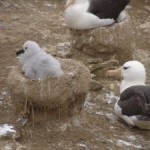 As I reached the north cliffs, the skies were covered with dense clouds. I was touched by the thousands of birds gliding through the shafts of the sun. They glided between the low heavens and pewter sea. Their braying and cooing lingers in the air. The scent of guano, too, is strong. The nests contain month-old chicks that sit like snowmen. As the adults arrive to feed them, I am spellbound. The adult albatross converts food into high-density oil that matches the calorific content of diesel. The parent and the chick greet each other with crossed bills. Following this, the adult squirts oil resembling the filling of a tank. Adults spend nearly 15 minutes feeding its chick. The chicks consume food three times its body weight. The adults then travel [...]
As I reached the north cliffs, the skies were covered with dense clouds. I was touched by the thousands of birds gliding through the shafts of the sun. They glided between the low heavens and pewter sea. Their braying and cooing lingers in the air. The scent of guano, too, is strong. The nests contain month-old chicks that sit like snowmen. As the adults arrive to feed them, I am spellbound. The adult albatross converts food into high-density oil that matches the calorific content of diesel. The parent and the chick greet each other with crossed bills. Following this, the adult squirts oil resembling the filling of a tank. Adults spend nearly 15 minutes feeding its chick. The chicks consume food three times its body weight. The adults then travel [...] -
Amazing Flight of the Albatross – Part – III
Posted in Wildlife A-Z | March 19, 2010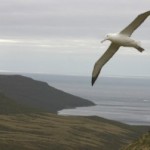 Campbell Island is the nesting place of the southern royal albatross. It lies 400 miles south of New Zealand. The island has fantastic waves and birds. The birds include giant petrels, shearwaters, and our very own albatross. The markings of the pintado petrels give them the appearance of flying dominoes. The tall cliffs obscure the island’s loneliness. There is a constant blowing of chilly winds. The Campbell albatross is unique to the island, with a grey head and light mantle. The brows are jet black in color. There are no vehicles on Campbell Island. The rhythm of the legs determines the time and distance covered. A 45-minute walk is the most direct route at leads to the birds. I have spotted many birds in the broad alley. I seem to misjudge [...]
Campbell Island is the nesting place of the southern royal albatross. It lies 400 miles south of New Zealand. The island has fantastic waves and birds. The birds include giant petrels, shearwaters, and our very own albatross. The markings of the pintado petrels give them the appearance of flying dominoes. The tall cliffs obscure the island’s loneliness. There is a constant blowing of chilly winds. The Campbell albatross is unique to the island, with a grey head and light mantle. The brows are jet black in color. There are no vehicles on Campbell Island. The rhythm of the legs determines the time and distance covered. A 45-minute walk is the most direct route at leads to the birds. I have spotted many birds in the broad alley. I seem to misjudge [...]


